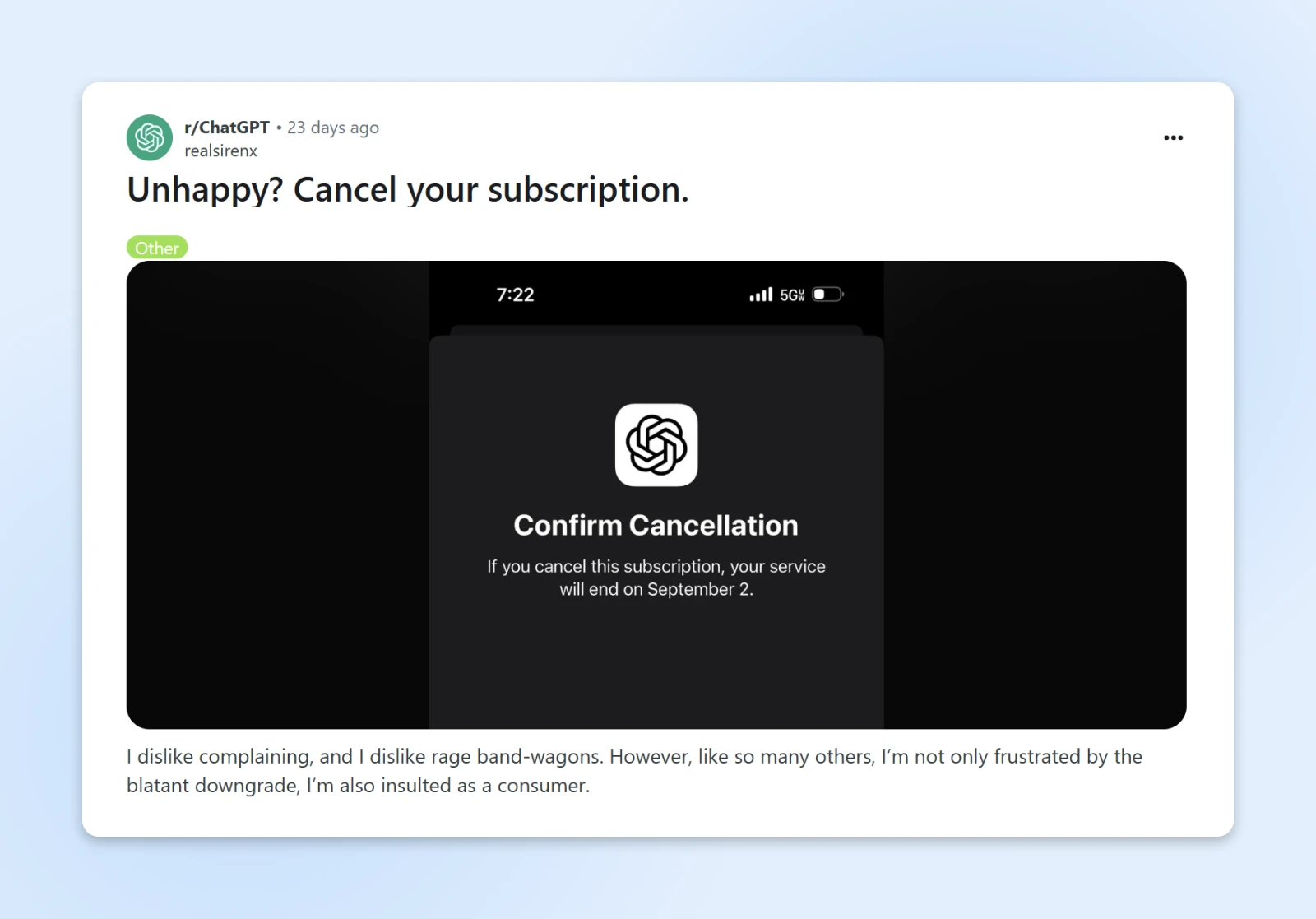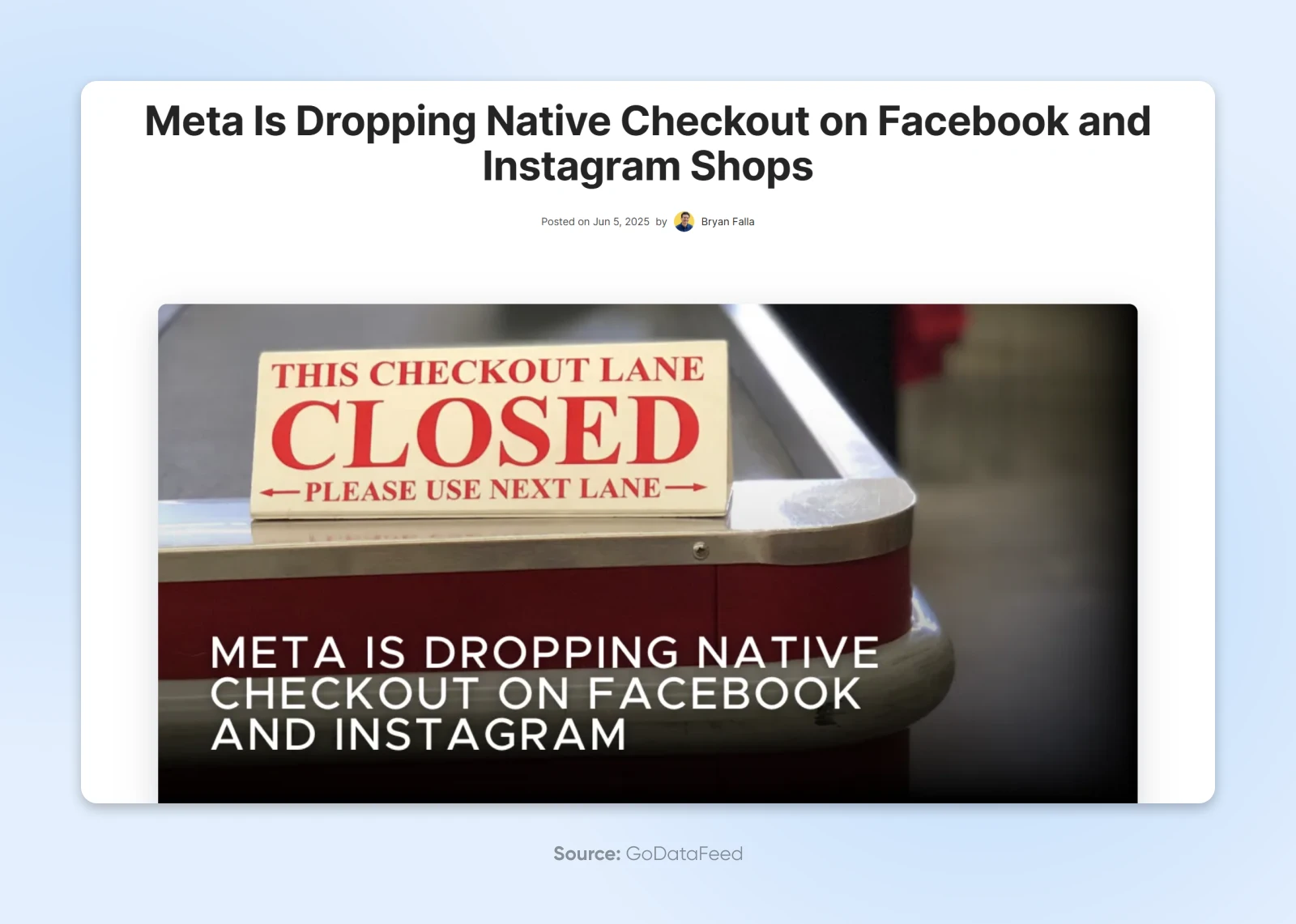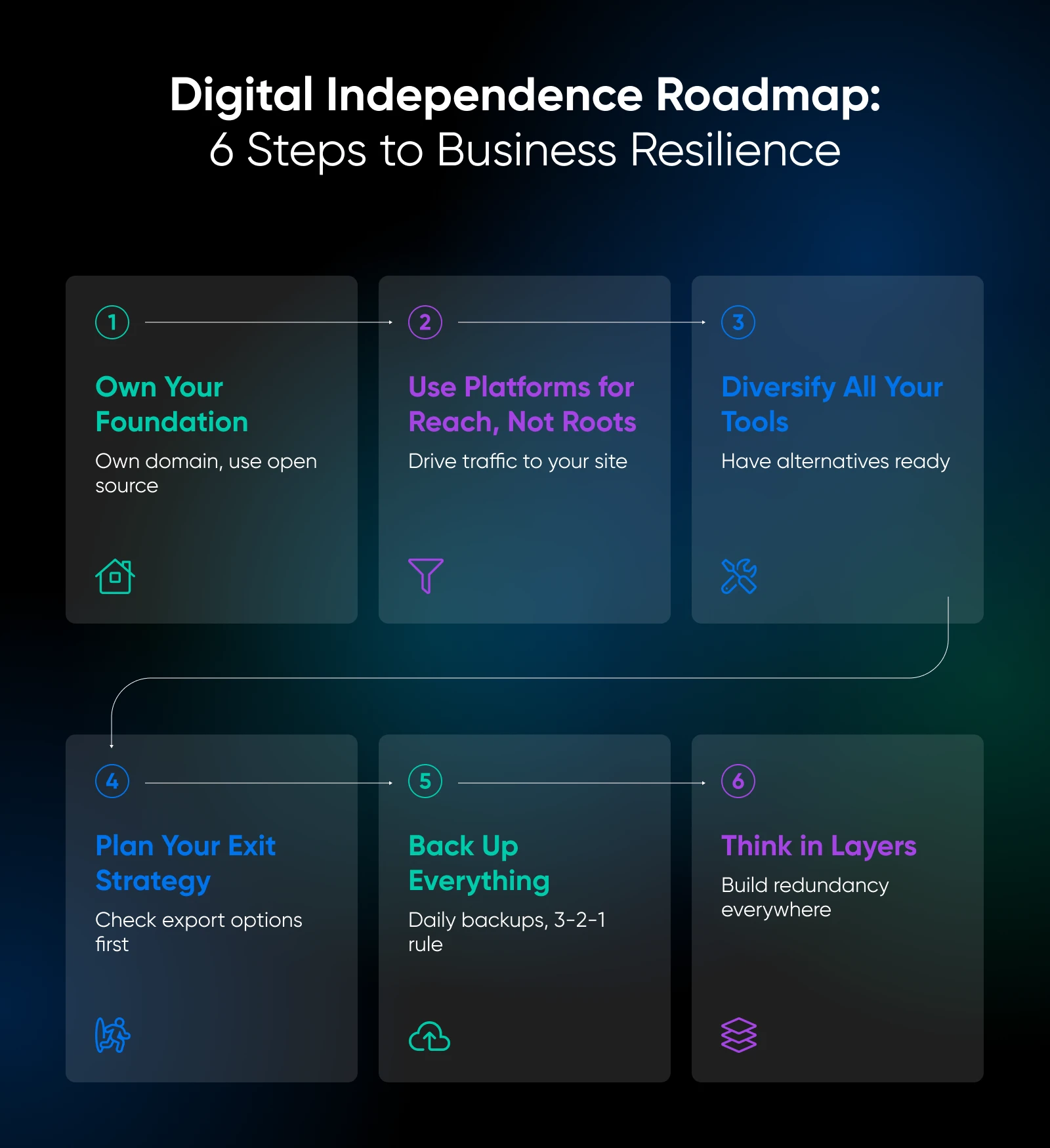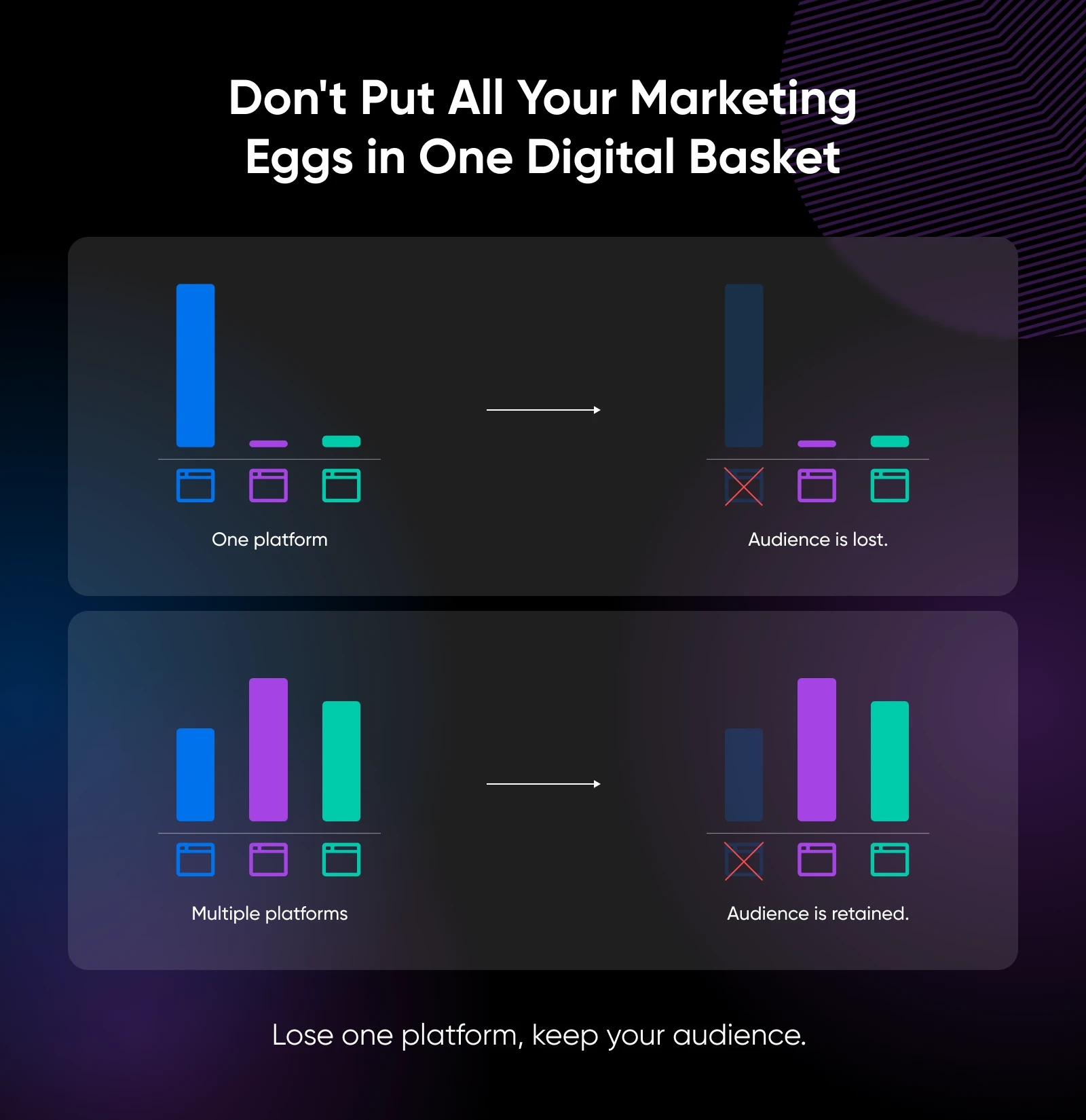TL;DR:
- OpenAI pulled a classic Big Tech move in August 2025: swapped everyone’s beloved GPT-4 for GPT-5 overnight without warning. Millions woke up to broken workflows and their warm, chatty AI “friend” replaced by a cold, corporate stranger.
- The internet collectively lost it: Reddit became group therapy. Subscription cancellations followed.
- OpenAI eventually caved and restored old models…but only for paying customers, leaving free users stranded: This wasn’t a bug, it was a feature: Big Tech changing rules without warning because they own the board.
- If your business runs entirely on someone else’s platform, you’re not a customer: You’re a digital tenant with zero rights.
- Use platforms for reach, but build your foundation on what you actually own: That means your domain, website, email list, and data live under your control.
Imagine going to your regular coffee shop before work, where the barista you see every weekday greets you with a smile and asks, “The usual?”
You say yes, expecting him to hand over your quad-shot dark chocolate mocha with a sprinkle of cinnamon, hold the whip —just what you need to start your day off right.
Instead, he slides a kale smoothie across the counter. And then looks at you like you’re the weird one for being, um, a little confused.
That’s pretty much how OpenAI customers felt when the company swapped everyone’s favorite models for GPT-5 overnight. One day, they had reliable digital sidekicks and tools. The next, they were staring at a stranger in the same uniform, insisting it could “totally do the job” while changing everyone’s order mid-sentence.
Okay, this metaphor got lost in the sauce, but you were there when GPT-5 rolled out! You saw the internet collectively freak out. Reddit threads read like group therapy. People begged for their old AI “friend” back.
Some canceled subscriptions in protest. OpenAI eventually gave in and restored some of the old models — but only for paying customers.

Funny as it was to watch unfold, there’s a serious lesson here — this wasn’t a glitch.
It was the system working exactly as designed.
When you build your business on somebody else’s platform, you don’t own the tools —they own you. Digital independence matters more than ever, and the GPT-5 mess was no isolated drama.
The GPT-5 Meltdown: What Actually Happened
On August 7, 2025, OpenAI quietly pulled the plug on its legacy GPT models, like GPT‑4 and GPT‑4o, and launched GPT‑5 as the new default for ChatGPT and Microsoft Copilot.

While OpenAI hyped up the new model, backlash was swift and fierce. Users mourned the demise of what they described as their warm, comforting digital companions, suddenly replaced with a much colder, more corporate-feeling GPT‑5.
In response to the uproar, OpenAI restored access to legacy models, but only for paid tiers, like ChatGPT Plus, leaving freemium users stranded with the new default GPT‑5.
Sam Altman admitted that OpenAI had “screwed up” and underestimated how much users valued the personality quirks of GPT‑4o, and promised that future model changes would come with more transparency and choice. Later, The Verge reported that OpenAI pledged not to remove older models without notice.
Beyond just a rough rollout, it was the moment millions realized, “Wait… my tools can vanish overnight.” While much of the backlash (and the headlines about it),focused on the emotional connections people had formed with the warmer, chattier older GPT models, the bigger story here is how OpenAI’s decision-making affects millions of customers — some of them paying business users —without warning or input.
How GPT-5 Wrecked Workflows
People didn’t just use GPT‑4o for whimsy. They built workflows around it: custom templates, tone-specific prompts, business automations, and more. Switching to GPT‑5 instantly disrupted routines and revenue-generating processes for many users, who lost money (and time) having to pivot when they woke up one morning and discovered their tool had fundamentally changed without warning.
There was no migration plan, no heads-up, no “legacy mode for a few weeks.” The switch flipped and that was that. It was when a lot of GPT users realized that even if they paid for Plus or Pro plans, they didn’t own anything —they were just digital tenants, and OpenAI could still do whatever they wanted. Except tenants usually have rights; your landlord can’t just decide to renovate and kick you out without any warning at all.
This illustrated a fundamental power imbalance that exists all over the web. If you build using someone else’s platform, your business may not actually belong to you. And that’s something a lot more business owners should be cognizant of.
This Isn’t New: The Platform Dependency Pattern
If this sounds familiar, it’s because it is. The concept of “ownership” online has always been a bit nebulous, and OpenAI is far from the first platform to pull a move like this. In fact, Big Tech has a habit of pulling the rug out from under its users, and the playbook is usually the same: lure people in with convenience, lock them into dependency, then change the rules in ways that benefit the platform, leaving users scrambling to adjust.
Here were a few other notable moments:
- Facebook’s algorithm switch-ups: Publishers who built their audience almost entirely through Facebook learned the hard way that the platform giveth, and the platform taketh away. When Facebook shifted its News Feed algorithm to prioritize “meaningful social interactions,” traffic to news and media sites dropped off a cliff. Some outlets lost more than half their readership overnight, and a few never recovered.
- Twitter/X’s API lockdown: Developers and small businesses had built entire products on Twitter’s API, including analytics dashboards, scheduling tools, and community apps. Then came Musk-era changes: higher fees, restricted access, and sudden shutdowns. Startups went bust not because their product failed, but because their foundation disappeared.
- Instagram’s e-commerce pivot: For a hot minute, Instagram Shops looked like the future of small-brand e-commerce. Then Meta deprioritized it, shifting resources elsewhere. Small businesses that had gone all-in on Instagram-only storefronts suddenly had to rethink their entire sales strategy.

The reason this keeps happening is simple: platform incentives aren’t your incentives.
Your goals are stability, continuity, and growth.
Their goals are monetization, efficiency, and market dominance. When those goals align, great. When they don’t, well, you lose.
When you view it through this lens, the GPT-5 situation isn’t unique. In fact, it’s predictable. And it’s a reminder that every time you tie your operations too tightly to a single platform, you’re betting your business on someone else’s business model.
OpenAI Was a Small Business Reality Check
If the GPT-5 drama felt like a peek behind the curtain, it was. And it wasn’t just about AI either —it was about all businesses online and the tools and platforms they depend on.
Right now, your business might quietly lean on:
- Content platforms like social media for discovery
- AI tools for automation and scalability
- Cloud services for storage and uptime
- Payment processors as the lifeblood of your revenue stream
Imagine losing Stripe’s payment processing features overnight. Or watching your custom AI prompts stopped in their tracks. That’s not hypothetical. It’s exactly what GPT-5’s surprise switch handed millions of creators and small businesses.
Every time you layer dependencies — AI, social platforms, cloud infrastructure, payment services —you’re building a tower of digital Jenga. Pull one block, and it might wobble. Pull the wrong one, and it might collapse.
So what can small business owners do? It’s not exactly practical to build a proprietary tool for every function your business needs online. We’re also not tech-nihilists or anti-AI — We’re not rejecting any tools or platforms.
What we are is pro-digital independence.
Digital Independence 101
Digital independence is a strategy: use platforms for reach and innovation, but build your business foundation on what you control.
Here are some guiding principles:
- Distributed systems are more resilient: When you don’t have any single points of failure, your business stays standing.
- Open standards keep you free: Make sure you can export your data, migrate it to a new platform, and pivot. It’s your data, not the platform’s.
- Your website and email list are your real HQ: Own the land, don’t rent it.
Think of independence as your digital insurance policy. It doesn’t stop the flood, but it builds you a boat. Platforms may shut things down, change rules, or shift strategies, but you make sure you still have a grounded place to operate from.
How To Put Digital Independence Into Practice
A few smart, intentional moves can dramatically reduce your dependence on Big Tech and give you peace of mind that your business won’t crumble when the next GPT-5-style drama hits. Here are steps you can take right now to make your business less fragile and more resilient.

1. Own Your Foundation
Your domain and website are the equivalent of owning the land and building for your business. If you only operate through a Facebook Page or Instagram profile, you’re basically renting space in someone else’s mall —and the landlord can lock the doors at any time.
What to do:
- Register your domain name: Pick something that reflects your brand and is easy for customers to remember. We can help.
- Build on open-source software: WordPress is the most common choice. Because it’s open source, nobody can suddenly take away your ability to run your site.
- Choose reliable hosting: With a provider like DreamHost, you control your site’s files and database. That means if you ever want to switch hosts, you can take your whole site with you.
This way, even if platforms shift their algorithms or pull features, your main business hub is safe and always under your control.
2. Use Platforms for Reach, Not Roots
Social platforms and AI tools are fantastic for getting attention and running experiments. But don’t confuse them with your business foundation. They should act as on-ramps, driving people to assets you actually own.
What to do:
- Always point traffic back to your site: Post your products on Instagram? Include links to your store on your own domain. Sharing content on TikTok? Funnel viewers to your blog or email list.
- Build your email list: Social media followers are fickle. An email list is yours forever. Use lead magnets (discount codes, free guides, or newsletters) to encourage sign-ups.
- Avoid “platform lock-in” storefronts: Selling only through Instagram Shops or Etsy makes you dependent. Running your own e-commerce store on WooCommerce or Shopify (with your own domain) gives you flexibility.
Think of platforms like rented billboards. They’re great for visibility, but your HQ needs to be somewhere you hold the keys.
3. Diversify All Your Tools
Relying on a single provider for payments, storage, or marketing is like running your business with only one supplier. If they stop delivering, you’re stuck.
What to do:
- Payments: Use at least two processors if possible (like Stripe and PayPal). If one has downtime or changes its fee structure, you’ve got a backup already in place.
- Data storage: Store files locally and in the cloud (Google Drive, Dropbox, or iCloud). Never assume one copy is enough.
- Marketing: Spread your efforts out. Instead of relying 100% on Instagram, build a presence on LinkedIn, Pinterest, and even your own blog.

By diversifying, you create redundancy. So if one provider pulls the plug, your entire operation doesn’t go down with it.
4. Plan Your Exit Strategy
Before you commit to a new tool, ask yourself: “How hard would it be to leave this platform?” If the answer is “Nearly impossible,” that’s a big red flag.
What to do:
- Check for export options: Can you download your customer list, content, or data easily?
- Avoid proprietary file formats: Stick to open formats like CSV, PDF, or standard databases whenever possible.
- Run a “breakup test”: Pretend the platform disappears tomorrow. Do you know where your data lives and how to migrate it? If not, create a plan.
This doesn’t mean you shouldn’t use closed platforms, but it means you should do your best not to be trapped by them.
5. Back Up Everything, All the Time
Backups are the ultimate insurance policy. Without them, a single hack, glitch, or policy change could wipe out years of work. With them, you can bounce back quickly.
What to do:
- Website backups: Use a host that provides automatic daily backups (DreamHost does). Or install a plugin like UpdraftPlus for WordPress.
- Customer and financial data: Export lists from your CRM, payment processor, or email platform regularly (at least once a month). Store copies securely in cloud storage.
- Personal files: Keep two backups; one on an external hard drive, another in the cloud.
💡Pro tip: Follow the 3-2-1 backup rule: 3 copies of your data, stored in 2 different formats, with 1 copy offsite.
6. Think in Layers of Resilience
Digital independence isn’t about rejecting platforms. It’s about making sure no single failure can take you down. The more layers of control you build into your business, the stronger you are.
- Own your website.
- Build your email list.
- Diversify your tools.
- Back everything up.
That’s it. No tinfoil hats required — just smart business planning.
By following these steps, you’re making sure your business doesn’t get sideswiped the next time a Big Tech platform decides to do what Big Tech does: move fast and break things.
Build Smart, Build Independent
The GPT-5 fiasco gave us all a real-time glimpse into the risks of tying your livelihood to platforms you don’t control. If that can happen with one of the most powerful AI companies in the world, it can happen anywhere: on social media, in your payment system, or in the cloud services you rely on every day.
But the good news is that you’re not powerless. Digital independence doesn’t mean rejecting platforms or refusing to use the latest tools. It means being strategic about how you use them. Own your core infrastructure. Keep your customer data close.
Build your foundation on assets no boardroom can take away with a single policy update.
With your website, domain, and data under your control, you can experiment freely with new platforms without risking collapse when the rules change. It’s not anti-tech;it’s pro-smart-business.
At DreamHost, we’ve been championing this philosophy for years. We believe in an open web where creators, entrepreneurs, and small businesses have the power to thrive on their own terms. Whether you’re just starting out or already running a digital-first company, the first step to resilience is simple: build on ground you own.
Ready to get started? Register your domain on DreamHost today to launch your website on open, flexible infrastructure and take ownership of your digital foundation.
The next time Big Tech decides to move fast and break things, you’ll be glad your business isn’t one of the things they can break.
Did you enjoy this article?



